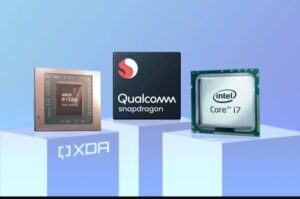
In 2025, the personal computing landscape is undergoing a tectonic shift—not just in performance or battery life, but in how your PC thinks. At the heart of this revolution is the rise of the AI PC—computers equipped with dedicated Neural Processing Units (NPUs) designed to accelerate on-device artificial intelligence tasks. The three giants vying for dominance in this emerging space are Intel, AMD, and Qualcomm. Each brings a different strategy to the table, and the winner could shape the future of everyday computing.
What Is an AI PC?
An AI PC is more than a buzzword. It represents a class of laptops and desktops that can run AI-powered tasks locally—speech recognition, image enhancement, translation, background blur, smart assistants—without relying on cloud processing. This shift boosts privacy, responsiveness, and energy efficiency.
At the center of this capability is the NPU, a specialized chip that handles AI workloads far more efficiently than CPUs or GPUs.
Intel: Meteor Lake and Lunar Lake Lead the Way
Intel was the first to make a splash with the AI PC concept, introducing its Meteor Lake chips in late 2023. These processors were the first from Intel to feature a discrete NPU, part of a tiled architecture that separates the CPU, GPU, and NPU onto different silicon dies.
Key strengths of Intel’s AI strategy:
Software partnerships: Intel has partnered closely with Microsoft and Adobe to optimize tools like Copilot and Photoshop for NPU acceleration.
Developer ecosystem: Intel’s OpenVINO toolkit enables developers to optimize AI workloads across CPU, GPU, and NPU.
Forward roadmap: The upcoming Lunar Lake chips, expected mid-2025, promise up to 3x NPU performance, bringing more advanced AI capabilities to thin-and-light laptops.
However, Intel still relies on x86 architecture, which can limit power efficiency compared to ARM-based rivals.
AMD: Riding In with Ryzen AI
AMD launched its AI initiative with Ryzen 7040 series chips in 2023, branding them under the Ryzen AI umbrella. Their NPUs are based on Xilinx technology, acquired in 2022, giving AMD a strong foundation in low-power, high-performance AI processing.
AMD’s AI push includes:
Phoenix and Hawk Point processors with integrated NPUs delivering competitive TOPS (trillions of operations per second).
Open AI toolchain via AMD’s ROCm and partnerships with Hugging Face and ONNX.
An aggressive move into commercial laptops, with Lenovo and HP adopting Ryzen AI for business-grade features like real-time meeting transcription and noise suppression.
While AMD lags slightly behind Intel in market presence and OEM partnerships, it has steadily improved NPU performance and energy efficiency.
Qualcomm: The ARM-Based Challenger
While Intel and AMD fight it out on x86, Qualcomm is betting on ARM. The company’s Snapdragon X Elite platform, launching widely in 2025, is poised to shake up the PC market.
Highlights of Qualcomm’s approach:
Massive NPU performance, with claims of 45 TOPS, well beyond current Intel and AMD offerings.
Built-in cellular connectivity and ultra-low power draw, ideal for always-on, always-connected laptops.
Deep integration with Windows on ARM, and heavy optimization for Microsoft’s Copilot+ PCs.
Qualcomm’s biggest challenges lie in x86 compatibility and software ecosystem readiness. While native ARM support is growing, many legacy apps still require emulation—though performance here has greatly improved.
The Verdict: A Three-Way Fight for the Future
The AI PC market is still in its early days, but the battle lines are drawn:
Intel has the lead in ecosystem support and developer tools.
AMD offers competitive performance with cost-effective options.
Qualcomm brings the most power-efficient and AI-capable silicon, threatening to flip the PC industry to ARM.
With Microsoft’s Copilot+ PCs and AI-enhanced Windows 11 experiences gaining traction, 2025 could be the year AI becomes as central to the PC experience as the CPU itself once was. The winner of this battle won’t just control chip sales—it will influence how billions of people interact with their computers in the AI era.
